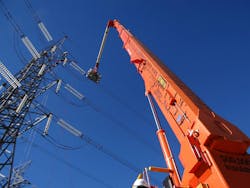Interview with Bronto’s Dominik Keller: Higher Working Heights
Dominik Keller, access segment director, Bronto Skylift, talks about safety beginning with training, digital lifecycle management tools, and more.
RER: What are the most important developments in mobile elevating work platforms in the past year - especially technology that would be of interest to rental companies?
Keller: In the past year, some of the most important developments in mobile elevating work platforms have focused on technology that improves overall efficiency, safety, and sustainability. Digitalization has introduced smarter fleet management tools, enabling monitoring and optimized maintenance. The MEWP is just a tool that is part of a wider toolbox with a lot of moving parts. Different brands of equipment, skilled and available workforce, efficient site planning and execution – all needs to fit seamlessly together for streamlined, profitable business. There is still a lot that can be improved in this area, and we wish to be in the forefront.
What’s new in your company’s MEWP offering over the past year or so?
Keller: We have a good offering in North America, and our aerials are well liked, especially the stability, reliability, and control system with built-in safety features. Our main focus is now in supporting the lifecycle of the well-known aerials and together with our local dealers we are strengthening our service footprint in North America. We are just opening a new Service Center in the Dallas area. It will be the main hub for mounting, training, support, maintenance and overhauls.
What are some of the most interesting applications for MEWPs that you’ve seen currently or over the past year or so?
Keller: Alongside the general continued adoption of truck-mounted platforms, we have observed a growing demand for insulated aerials combined with higher working heights, particularly for utilities and infrastructure-related tasks.
Rental companies can all read the manufacturers instruction or IPAF “how to use” documents, and pass that documentation on to the customers, but what are some of the most important tips or suggestions for safety on aerial equipment that you would like to pass along to rental companies? What are the most common mistakes renters of aerial equipment make?
Keller: Safety begins with training and is reinforced by consistent service and daily checks. The most important elements to emphasize are:
- Ensure operators are properly trained by the manufacturer.
- Follow timely service intervals in strict accordance with manufacturer recommendations.
- Perform daily pre-use inspections to identify any issues early.
- Remember that operator skill and awareness are central to safe operations; investing in skilled personnel directly impacts brand reputation and accident prevention.
Looking ahead, what are the next new development or developments in aerial equipment technology? What are some developments you would like to see? What’s on the horizon?
Keller: The next stage of development in aerial equipment will likely come from the continued convergence of digitalization, safety, and sustainability. Emerging technologies will give fleet managers better access to real-time insights on equipment condition, usage, and location. Predictive maintenance will further reduce downtime.
Looking forward, we would like to see an industry-wide focus on:
- Broader adoption of digital lifecycle management tools
- Expansion of specialized operator training programs
- Further investment in safety innovations
- Continued progress in emission reduction and electrification
All these developments point to a promising future for the working-at-height industry globally, offering rental companies a strong outlook for both demand and innovation.
About the Author
Michael Roth
Editor
Michael Roth has covered the equipment rental industry full time for RER since 1989 and has served as the magazine’s editor in chief since 1994. He has nearly 30 years experience as a professional journalist. Roth has visited hundreds of rental centers and industry manufacturers, written hundreds of feature stories for RER and thousands of news stories for the magazine and its electronic newsletter RER Reports. Roth has interviewed leading executives for most of the industry’s largest rental companies and manufacturers as well as hundreds of smaller independent companies. He has visited with and reported on rental companies and manufacturers in Europe, Central America and Asia as well as Mexico, Canada and the United States. Roth was co-founder of RER Reports, the industry’s first weekly newsletter, which began as a fax newsletter in 1996, and later became an online newsletter. Roth has spoken at conventions sponsored by the American Rental Association, Associated Equipment Distributors, California Rental Association and other industry events and has spoken before industry groups in several countries. He lives and works in Los Angeles when he’s not traveling to cover industry events.
